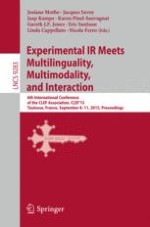2015 | Book
Experimental IR Meets Multilinguality, Multimodality, and Interaction
6th International Conference of the CLEF Association, CLEF'15, Toulouse, France, September 8-11, 2015, Proceedings
Editors: Josanne Mothe, Jacques Savoy, Jaap Kamps, Karen Pinel-Sauvagnat, Gareth Jones, Eric San Juan, Linda Capellato, Nicola Ferro
Publisher: Springer International Publishing
Book Series : Lecture Notes in Computer Science
